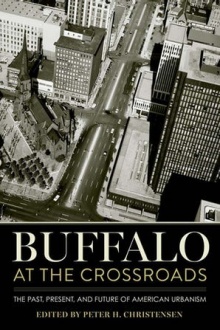Buffalo at the Crossroads
The book consists of four chapters and the last chapter Buffalo as Palimpsest referes to the writing and rewriting of the city by a range of authors featuring essays by our very own faculty members Erkin Özay and Hadas Steiner.
Özay's essay, "Rust Belt Cosmopolitanism: Resettlement Urbanism in Buffalo, New York" explores how resettlement embodies a viable force in transformation of Aerica's weak market cities. Like Buffalo’s peers in the Rust Belt, the city offers affordable environments, cooperative city governments, and welcoming public seeking to impede population decline and foster urban revitalization. By focusing on Buffalo, known as “preferred resettlement community,” Özay provides insight into the workings of this resettlement urbanism, condition by a loosely coordinated network of institutions.
In “Cropping the View: Reyner Banham and the Image of Buffalo,” Hadas Steiner employs the city of Buffalo as a tool to study the history of architecture itself. Steiner makes the provocative argument that the deployment of architectural history in Buffalo demonstrates how scholarship can be misused to justify policies that reify segregation. She notes the commonplace co-option of cultural capital by politicians and developers while prognostically exploring how disciplinary resources might be directed elsewhere, stemming the growth tide of what she describes as spatial injustice in Buffalo and beyond.
The essays in Buffalo at the Crossroads proffer a dual register for understanding Buffalo's myriad guises as at once an exceptional and a prototypical American city. The authors of this volume employ varies and innovative methodologies to unearth new facts and new stories that deepen our understanding of this important American city. It is a diverse set of cutting-edge essays.
The essays examine Buffalo's architectural heritage in rich context: the Second Industrial Revolution; the City Beautiful movement; world's fairs; grain, railroad, and shipping industries; urban renewal and so-called white flight; and the larger networks of labor and production that set the city's economic fate. The contributors pay attention to currents that connect contemporary architectural work in Buffalo to the legacies established by its esteemed architectural founders: Richardson, Olmsted, Adler, Sullivan, Bethune, Wright, Saarinen, and others.
This book is a compelling introduction to Buffalo's architecture and developed landscape that will frame discussion about the city for years to come.
Author
Chapter - "Rust Belt Cosmopolitanism: Resettlement Urbanism in Buffalo, New York" by Erkin Özay
Chapter - “Cropping the View: Reyner Banham and the Image of Buffalo" by Hadas Steiner
Publisher
Cornell University Press
Date Published
2021
Contributors
Marta Cieslak, University of Arkansas - Little Rock; Francis R. Kowsky; Erkin Özay, University at Buffalo; Jack Quinan, University at Buffalo; A. Joan Saab, University of Rochester; Annie Schentag, KTA Preservation Specialists; Hadas Steiner, University at Buffalo; Julia Tulke, University of Rochester; Stewart Weaver, University of Rochester; Mary N. Woods, Cornell University; Claire Zimmerman, University of Michigan
